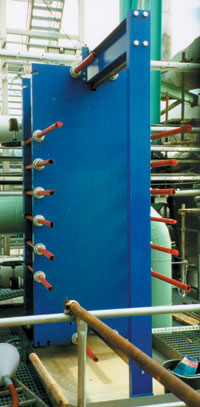The sulphuric acid plant and district heating
In the early 1980s, Kemira changed its acid cooling system from direct cooling to heat recovery. In the direct cooling system, the heat from the absorption and drying towers was emitted to the sea. With the heat recovery system, the heat is instead transferred to a closed loop cooling water circuit containing demineralized water. This water is heated and the hot water is used to heat district heating water for the city of Helsingborg.
DATA 2025-06-08
By 1999 Kemira decided to totally rework their acid cooling system and among other things replaced all the old coolers with three semiwelded Alfa Laval plate heat exchangers.
The plate heat exchanger makes it possible to economically recover the heat from the circulating acid in the drying and absorption towers. By installing a closed loop of cooling water, the heat can be used for other purposes such as district heating, boiler feed water preheating, process heating in adjacent plants, space heating of factories and offices and production of fresh water by desalination.
In the Kemira sulphur burning acid plant, with a capacity of 1000 tons per day, around 530 MWh is recovered from the drying and absorption towers per day. This heat is delivered to the district heating network of the city of Helsingborg. For Kemira, the delivery of heat has become an important complementary product to sulphuric acid and other chemicals. It has also nearly eliminated the need for cooling water.
The payback time for the heat recovery system introduced in the 1980s was less than a year.
Products
Alfa Laval Industrial semi-welded line is used for all types of refrigerants, or in other processes where gaskets are not suitable for one of the media.
Benefits
- High degree of heat recovery
- Small heat transfer area
- Lower investment and installation cost
- Full counter-current flow, providing the capacity to handle crossing temperature programs
- Ability to handle close temperature approaches
